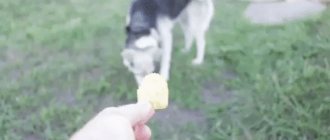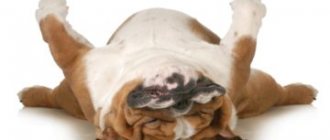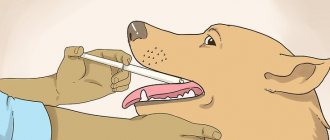Purpose of the collar
A dog collar serves several functions. Firstly, it is designed to limit the freedom of movement of the animal, and in combination with a leash, it is the main means of control over the dog. This is perhaps the most important functional purpose of collars and harnesses, and ensures both the safety of others and the pet itself. Secondly, the collar often performs a decorative function and acts as a mandatory accessory when a dog participates in competitions and exhibitions.
In addition, the collar is used to correct the animal’s behavior during training and walks, to attach a name tag with the address and telephone number of the owner, as well as to control the animal in the dark (luminous models).
General recommendations from dog handlers on the selection and use of collars
- Do not purchase products with spikes or rivets on the outside of the collar. They can injure surrounding people and animals. Your pet may injure its paws while trying to remove the product from its head. While playing, the dog may accidentally bite off the rivet and swallow it.
- Evaluate the reliability of the collar accessories (clasps, locks, rings).
- Decorative inserts on the collar should not cause discomfort to your dog.
- The collar should be periodically wiped with a damp cloth and cleaned of dirt.
- If the metal elements of the product are rusty, they need to be replaced. The collar can be coated with a special compound that prevents the formation of rust.
- Never put someone else's dog's collar on your pet. You can infect your animal with an infection or parasites.
- The width of the collar should be selected depending on the size of your pet.
- The collar buckle should be at some distance from the ring. This design will help to evenly distribute the load on the equipment.
- The diameter of the neck may change due to various circumstances (molting, time of year, etc.). A leather collar also changes its size (stretches when wet and shrinks when dry). Taking these circumstances into account, you should choose a product with the maximum number of holes.
- The collar should not be too tight.
- Multilayer equipment has great reliability and durability.
- You should not buy collars with plastic fittings. Plastic fasteners are not very reliable and break easily in the cold.
- On the website of collar manufacturers you can find special tables that will help you choose ammunition.
- Cheap metal collars may have poorly processed links, the surface of which is covered with jagged edges. The collar must be carefully inspected before purchase for mechanical damage.
Briefly about the purpose
Planer, or parfors, is equipment that is used for training large or hyperactive breeds of dogs . It allows you to train your pet and correct the aggressive behavior of complex breeds.
Did you know? Dog collars have been used since the ancient world. So, for example, in the 9th century. BC. The Chaldeans, who noticeably did not get along with Babylon, used swift and powerful dogs when attacking, wearing heavy metal collars with sharp curved knives.
These are metal links, inside of which there are spikes with rounded teeth, and they are located at an angle to minimize possible injury to the animal. Usually the end of the collar is not fastened, but passed through a ring.
When pulled, it tightens and the spikes impact the dog's neck. As soon as the animal takes the correct position, the tension weakens, the ends separate, and the discomfort disappears.
Video: features of using a strict collar in training When teaching a pet a certain command, for example: “near” or “fu,” the trainer/owner sharply pulls the leash, and the spikes with a certain force compress the animal’s neck, forcing it to obey.
The strength of the jerk and the frequency of use depend on the pet’s learning ability and are used at the discretion of the owner.
What types of collars are there and how to choose them?
First type: Casual. Casual ones are designed for walking. Such a collar can be either leather or canvas. They are suitable for dogs of almost any breed, except those whose neck thickness is greater than the diameter of the head. When buying a collar for daily use, you must remember that your pet’s neck is the most vulnerable place, so the collar:
- must be strong enough, but not rigid, so as not to injure the pet;
- should fit tightly around the neck so that the dog cannot throw it off, but do not squeeze;
- should be comfortable - nothing should interfere with it, not excluding attractiveness;
- should not fade - this is easy to check: run your wet hand along its inside, there should be no paint left on your hand.
There are a huge number of different everyday collars available in stores, so choose based on comfort and quality rather than beauty. We also need to say something about luminous collars. In general, the idea is very useful, given that you often have to walk your animal in the dark. But such collars, as a rule, are not very reliable, so it is recommended to wear them over a regular one.
You can also attach a metal plate with the contacts and address of the owner to the collar in case the animal gets lost.
Second type: Exhibition. Exhibition ones can be chains or rings. Chains are used mainly for demonstrating animals at exhibitions - they allow both long-haired and short-haired dogs to look impressive and demonstrate themselves in all their glory, without distracting attention from the collar. When buying a chain, you should not take a model that is too tight or too loose, and you also need to pay attention to the strength of the chain, since a weak chain can break from a strong jerk.
Show rings are matched to the color of the dog in order to be least noticeable. Show rings are made either of leather or braided cord. The thinner such a leash, the more rigidly it controls the dog, so for puppies and decorative breeds it is better to use wider rings.
Third type: Snatch or noose. The noose is used to train a dog, wean it from lunging at people and other animals, and teach it the “near” command. The choke is a regular collar with a free-sliding loop - if the pet shows disobedience, you can pull on the leash and the choke will squeeze his throat, and when the dog steps back, the tension will decrease.
You need to put on such a collar in such a way that the top ring (to which the leash is attached) is on the back of the neck for better controllability. The snatch can be either leather or consist of metal links. The main thing is that it can withstand the dog’s jerk and is not too tight or too loose - since in neither case will the collar give the desired educational effect.
Absolute control over behavior
Fourth type: Parfors (strict). Parfors is intended for strict training and correction of behavioral problems in large dogs. The principle of operation of a strict collar is that a number of blunt spikes are placed on the inside. When pulled or simply pulled, these spikes create pain in the dog.
A strict collar is either purchased or made to order, taking into account the size of the dog. When using it, you need to remember that it must be well adjusted in size in order to have an effect and not cripple the dog. Parfors should be used in doses; it is also strictly forbidden to tie an animal in parfors.
You also need to wear a strict collar correctly:
It makes no sense to put the parfors on over the head, since then it will end up on the central part of the dog’s neck and will not bring the desired effect. Therefore, you need to put it on only by fastening it (if the parfors consists of links, you need to remove the extra links), passing it just under your ears; In order to check that the parfors is dressed correctly, try to insert your finger between the dog’s neck and the spike; if this is difficult, you will know that you did everything correctly.
In many European countries, the use of strict collars is prohibited at the legislative level as a means of causing pain and fear to animals. However, as a training tool, parfors does not yet have a worthy alternative. In a regular leather collar, you have to jerk harder, which can injure your pet much more significantly.
For small breeds of dogs, as well as for breeds with a weak neck structure, it is recommended to buy not a collar, but a harness, as it will not allow injury to the animal’s neck. If there is a need to wear a collar constantly (for example, during illness to support the collar), then choose the softest option possible.
Terms of use
An equally common question is how to use a dog collar. After all, failure to comply with the operating rules can not only damage your pet’s health, but also cause addiction.
The basic rules are:
- It is necessary to use the planer only during special activities, since wearing it for a longer period of time leads to irritation on the animal’s skin and is also addictive.
- The accessory should not be used during daily walks, as dogs learn by association. If for a long time the dog has negative associations between walks and pulling on the leash, then in the future this can cause aggression directed towards other four-legged animals that previously attracted interest and were the culprits of pulling on the leash.
To correct a dog's behavior, you need to pull it briefly and moderately. The planer is designed to quickly correct your pet's behavior by sharply tugging, which causes pain.
You shouldn't wear parfos all the time while walking.
If the pet makes a sharp jerk forward, then the owner needs to briefly but firmly pull the leash. Next, the pressure needs to be gradually eased, this will allow the pet to come to its senses and slightly reduce its ardor.
Prong collars are strongly discouraged for small puppies as they are intended for older, unruly animals to learn to behave.
As a rule, strict collars are used for those animals that cannot be trained in more humane ways. In the case of small puppies, the planer will only frighten them and, with careless movements of the baby, can injure not only the skin, but also soft tissues.
For your information! More and more animal rights activists are raising the issue of abolishing the use of such an inhumane means of influencing animals.
What types of accessories are there?
An inexperienced owner may become confused when he sees the widest range of products on the market. Different materials, sizes, prices and appearance sometimes make it difficult to choose which collar is best for a dog.
In fact, the main thing is to decide for what purpose the item of clothing will be needed, and also to take care of the comfort of your furry friend, because this item will be worn often and for a long time, so it should be comfortable for him. The most popular are walking collars, which have the following differences:
- Made from leather. An excellent option if you choose good quality material. In this case, the collar turns out to be soft, flexible, durable and wear-resistant. Leather items can be washed and coated with water-repellent agents to prevent them from getting wet. There is practically no smell, the dog’s neck is not subjected to much stress.
- Nylon. An invention of recent years, which instantly received well-deserved recognition from dog owners. Nylon fits better to the animal’s body and is superior to leather in almost all respects, especially in strength. Again, you should only buy high quality items. Today it is believed that nylon is used to make the best dog collars.
- Metal ammunition. Undoubtedly, a beautiful short-haired dog will look great in an elegant product woven from metal links. However, it is worth considering that it is better to wear such things “on the go”, since metal has some disadvantages:
- quite heavy;
- heats up in the sun;
- gets very cold in winter;
- can contribute to the formation of bald spots on short hair, and form tangles on long hair.
Don't forget about the option of harnesses - an excellent replacement for collars, much safer for your health. We recommend purchasing the Easy Walk corrective harness model. It is made of durable nylon, and safely stops the dog if it suddenly decides to make an instant lunge forward and run somewhere.
If you need to choose a dog collar for every day, then it is better to choose a leather or nylon one. The former look more elegant, the latter are often covered with reflectors and patterns; nylon itself boasts interesting bright colors. Additionally, nylon accessories usually come with durable plastic fasteners that are easy to snap into place.
What criteria are used to determine the quality of a product?
First of all, it is advisable to make purchases in specialized stores or on Internet sites that have a good reputation. It is better to give preference to well-known manufacturers who have been producing products for animals for several years and have positive user reviews. However, many parameters cannot be selected online, so it is better to choose directly at the pet store. You need to pay attention to the following points:
- if there are seams, they must be absolutely even or made outward, otherwise they will rub the skin;
- glued collars are immediately subject to rejection; only sewing with even stitches with equal steps is accepted;
- buckle fastening areas are treated with reinforced seams or cross-stitched;
- There should be no sharp chemical smell coming from the ammunition; to check, you can rub the collar with your hands;
- be sure to check for strength and elasticity by twisting and folding the product; material that is too soft will not withstand long-term use;
- All fasteners, carabiners, rings must also be carefully inspected - too fragile fittings will break in the very first days of use.
Important! It is necessary to check the warranty period. The absence of a warranty automatically serves as a signal of low quality of the product. Good leather and nylon can last at least three years without losing too much of their presentable appearance.
Types of collars
Main functions To begin with, it is worth paying attention to what your dog needs a collar for. If you exclude the decorative function from the main ones, when choosing, you should focus specifically on the functional aspects:
- A collar is necessary for training a dog and can become one of the anchors of behavior correction methods.
- A leash is attached to the collar, which helps limit and correct the dog’s movement during a walk or “running errands”.
- It is convenient to attach a tag with your phone number or address to the collar in case the dog gets lost.
- Collars can have a practical distinctive feature. One of the striking examples is the “strict” collar (the professional name is parfors).
Show collars
According to the regulations of the RKF, it is prohibited to bring dogs into the ring wearing a harness or harness. In addition, it is not customary to exhibit a show dog on a tape measure or leash and in a regular collar.
For dog shows, they usually choose ammunition made of leather or metal (chain collars), as well as economical synthetic material. Leather collars decorated with metal, rhinestones and other decorative elements are popular. The chain attracts and focuses attention on the merits of the dog’s exterior and the beauty of its coat. Many breeds of dogs, especially service dogs, for example, Dobermans, shepherds, at an exhibition have to not only parade or stand in the correct stance, but also run. Moreover, the dog must walk in front of the owner, and its head must be raised. In such cases, show collars with an Adam's apple and rings made of iron or leather are chosen.
A ringovka is a collar that tightens when the leash is pulled. The name comes from the word “ring”, i.e. This equipment is intended specifically for exhibitions.
The simplest rope ring
When choosing a chain option, be sure to make sure that it is made of high-quality alloy. Metal oxidation can cause allergies, irritation and dermatitis in pets. And some alloys can be dangerous for a dog’s life.
Behavior correctors and training collars
Strict collars.
The most popular is the parfors we have already mentioned. It is chosen based on the size of the dog and its coat. For example, for large dogs with thick hair (Malamute, Newfoundland, St. Bernard, Moscow Watchdog, Caucasian Shepherd, etc.), “grinders” with long metal spikes inward are suitable. Thanks to the wool, such a collar will not cause serious injuries or pain to the dog, but when the leash is pulled, it will cause noticeable discomfort. For powerful animals with short hair (Stafford, Bull Terrier, Great Danes, etc.), if you choose a strict collar, then one with small and rounded spikes at the ends.
When choosing a strict collar, select the size so that the spikes do not initially fit against the dog’s neck. The collar in the free position should hang freely on the animal.
Nooses and half-nooses.
Can be made of any material. In their principle of action, they are similar to ring rings, and are a free-sliding loop that tightens around the animal’s neck with sudden movements. The nooses have a fixed ring attached to which the leash carabiner is attached.
Electronic collars and shock collars.
The collar contains a battery that allows you to send light electrical impulses to the dog if commands are not followed. The negative reinforcement method is widely used in training. The editors of our site do not support such methods, however, dog handlers claim that the discomfort experienced by a dog is comparable to a mosquito bite. Who knows. However, we believe that this is much better than hitting dogs.
"Anti-bark" collars.
Anti-barking collars can help you cope with obsessive vocal reactions of your four-legged friends. There are water, sound and vibration options. The mechanism is triggered when the dog begins to bark, depending on the collar model, the pet receives a stream of water, or feels a sharp sound/vibration signal.
Before weaning your dog from barking in this way, you should consult a specialist to rule out nervous disorders or physical ailments. Such collars may not have a very good effect on the dog’s psyche, so they are not recommended for long-term use.
Guard options.
The strap in such a collar first passes through the half ring, and only then is fastened to the harness. If the dog jerks, the tugging force will be applied not to the buckle, but to the dense material passed through the ring. The buckle is located on top so as not to make the dog uncomfortable.
Unusual everyday and walking collars
GPS tracking collars.
The development of the IT industry has also affected dogs. A GPS dog tracking collar is linked to a satellite and will allow you to track your missing dog wherever he is while the collar is on. In the case of using such ammunition, you need access to the Internet, as well as a device that will receive the signal (smartphone, tablet, laptop, etc.). It is worth noting that GPS collars are not cheap, but for many dog owners they are a real salvation! GPS collars can be equipped with GSM SIM cards. In this case, the owner can send an SMS to this card and receive the coordinates of the dog’s location in response.
Reflective and LED collars.
In order not to lose your dog while walking in the dark, and also to avoid an accident involving a dog, it is convenient to use a luminous collar. You can choose a reflective option or stickers that acquire a noticeable optical effect when light rays hit them; collars with light-accumulating phosphorus coating (they will glow only if you first hold them in the light for a long time). As well as ammunition options with built-in LED lights or flashing beacons. Many collars of this type have several glow modes (almost like New Year's garlands).
When choosing an LED collar, study its design. Better are those where you can change the battery, and all elements are protected from moisture and dust.
Medical collars
Everyone knows the options that protect your dog from fleas, ticks and other parasites. Such accessories are not independent equipment, and are usually worn in addition to the main collar, so we will not dwell on them in detail here. We would only like to remind you that an anti-flea collar is not a 100% guarantee of animal protection and is used in combination with other means.
Decorative collars
Typically used for small breed dogs (Yorks, Spitz, Toy Terriers, etc.). In addition to visual appeal, they can also have a functional value (any of the above). In modern stores you can often find decorative collars decorated with gold, precious and semi-precious stones.
Decorative elements should not cause the dog discomfort, much less pain.
How to remove the product
Anti-aggression dog collars are important not only to put on and wear correctly, but also to remove. You need to remove the collar in the same way as putting it on. To do this, you need to unfasten the carabiner from the chain, thus disconnecting the links or opening them. You can open the links with your fingers; there should be no difficulties in carrying out the manipulation.
How to remove parforce correctly
If the pet owner encounters difficulties while using the collar, he should definitely consult with a dog handler or an experienced trainer. The fact is that improper use of a planer can cause even greater damage to the psyche of an uncontrollable animal.
Don't underestimate the importance of choosing the right accessory. A wide range of these devices can be seen in pet stores, so choosing the right one is not difficult.
How to choose the size of a dog collar
To choose the right collar, you need to determine the thickness of your pet’s neck.
Since the collar does not fit tightly to the skin, you need to add a few centimeters depending on the type of collar. The location of the collar on the neck may vary depending on the type of collar:
- For everyday collars, an addition of 5 cm is enough, the measurement is taken closer to the base of the neck.
- Straps will require a slightly larger increase - 6 cm.
- A strict collar is worn higher, as close to the dog’s ears as possible. It is better to take it a little longer, since the extra links can always be removed, but a collar that is too short will not put the right pressure on the dog.
To measure correctly, the dog must be standing or sitting. The measuring tape should not sag or be too tight.
Common collar sizes:
- S (decorative, up to 35 cm),
- SM (small hunting and service, 35-41 cm),
- M (medium, 41-48 cm),
- ML (large, 48-55 cm),
- L (large, more than 55 cm).
Selecting parfors for a dog
Each collar is selected individually. Incorrect selection can cause:
- excessive long-term pain;
- trauma with infection;
- fright;
- aggression;
- refusal to follow commands and obey.
You must purchase a collar together with your dog. Taking accurate measurements in a store and trying on a collar is easier than returning and replacing it.
Size selection
Collar diameter and size are not the same thing. An owner who does not have experience cannot choose the right collar. It's better to have a specialist do it.
Which collar to choose for a puppy
When choosing a collar for a puppy who is ready to start walking, you need to emphasize the lightness of the collar.
For a sensitive baby, it is better to choose a leather collar with a steel fastener, which will definitely not cause an allergic reaction.
You can also buy a soft collar for puppies, the size of which can be easily adjusted using a buckle (usually nylon collars). The collar strap also requires attention, as it can get in the way of the puppy.
A collar is very important for both dogs and humans. A properly selected collar will please the owner’s eyes, make the walk enjoyable and will not harm the dog. This means that you need to take the time to select the best collar for your four-legged friend.










